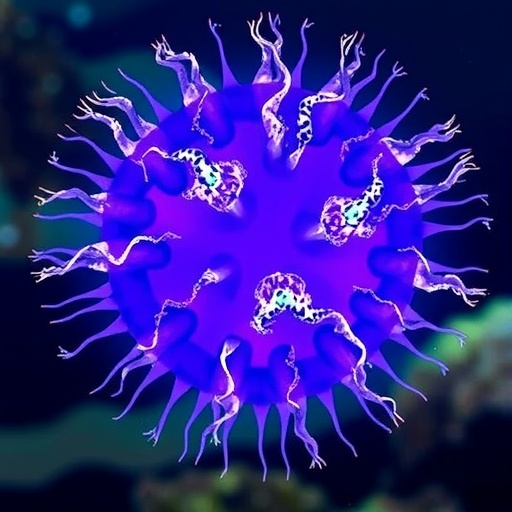In a groundbreaking study published in the journal Environmental Monitoring and Assessment, researchers have unveiled compelling insights about the suboxic waters of the eastern Arabian Sea. This unique marine environment, characterized by its low oxygen levels, has emerged as a crucial habitat for a diverse array of marine life. The focus of the study is the secondary chlorophyll maximum, a phenomenon primarily driven by heterotrophic dinoflagellates of the genus Pronoctiluca. Their presence in these oxygen-depleted environments raises important questions about the dynamics of marine ecosystems and the adaptability of life in extreme conditions.
The Arabian Sea, known for its complex oceanographic features, is witnessing alarming changes due to climate change and human activities. In these suboxic regions, where oxygen levels fall below critical thresholds, the conditions create a niche for specific organisms that thrive in such environments. Researchers observed that these adaptations allow Pronoctiluca spp. to not only survive but flourish, thereby drawing attention to their ecological significance. The study indicates that these dinoflagellates contribute substantially to biogeochemical cycles, shedding light on their role as indicators of changing marine habitats.
One of the most astonishing findings of this research is the abundance of chlorophyll within the layers of the water column characterized as suboxic. These chlorophyll maxima reflect the unique ecological processes at play, where photosynthesis and heterotrophy are intricately linked. The study highlights that the spatial distribution of Pronoctiluca blooms correlates with nutrient availability and the stratification of water masses. This relationship underscores the impact of oceanic conditions on phytoplankton dynamics and their subsequent influence on higher trophic levels.
The significance of understanding Pronoctiluca dominance is profound, especially in the context of global climate change. As ocean temperatures rise and nutrient input fluctuates due to anthropogenic activities, the traditional paradigms of marine productivity are under scrutiny. The resilience of heterotrophic dinoflagellates in suboxic conditions may suggest shifts in trophic interactions within these highly sensitive ecosystems. This study serves as a critical reminder of the need to reevaluate our understanding of marine food webs, especially in regions impacted by hypoxic phenomena.
Furthermore, the implications of this research extend beyond ecological analysis. It raises essential questions regarding the sustainability of fisheries in the Arabian Sea, which rely on the delicate balance of these marine ecosystems. As organisms like Pronoctiluca regulate nutrient cycling and energy flow, any perturbation to their populations could have cascading effects on fish stocks, potentially impacting livelihoods and food security for millions of individuals.
The study’s authors emphasize the importance of continuous monitoring of oceanographic parameters to assess the health of marine systems. Understanding the nuances of chlorophyll dynamics and dinoflagellate populations will enable scientists to predict future shifts in marine biodiversity and ecosystem functions. By employing modern techniques and methodologies, researchers can accurately assess how these ecosystems respond to environmental changes, thus informing conservation and management strategies in real-time.
Furthermore, the research draws attention to the importance of interdisciplinary approaches in oceanography and marine science. Combining expertise from biological, chemical, and physical oceanography allows for a comprehensive understanding of these suboxic environments. As marine scientists continue to explore the depths of the Arabian Sea, the need for collaboration between various scientific disciplines becomes increasingly clear.
The unexpected dominance of Pronoctiluca spp. in the eastern Arabian Sea poses new challenges and opportunities for marine research. While they perform vital ecological functions, the factors contributing to their proliferation in suboxic waters necessitate further exploration. What genetic adaptations allow these dinoflagellates to thrive despite the harsh conditions? How might their presence influence the overall productivity of the ecosystem? These questions highlight the potential for future research to yield even more information about the complexities of marine life.
As the global community faces rising sea levels and increasing ocean acidification, studies like these underscore the urgent need for a comprehensive understanding of marine ecosystems. Identifying the species and interactions that define these habitats will be critical in developing adaptive management strategies. Policymakers should consider such research when creating frameworks for marine conservation, ensuring that they account for the dynamics of suboxic zones and their unique residents.
To fully appreciate the findings of this research, it is essential to recognize the deep connections between land-based activities and marine health. Nutrient runoff from agriculture and urban areas can exacerbate the conditions leading to hypoxia, pointing toward the necessity of integrated coastal management practices. By addressing terrestrial contributions to marine environments, we can enhance our efforts to protect delicate marine ecosystems.
With ongoing climate changes, monitoring and understanding the adaptive mechanisms of marine organisms like Pronoctiluca will play a pivotal role in predicting the future of our oceans. Researchers must focus on gathering data to model how these organisms respond not just to current conditions, but also to anticipated changes in climate and water quality.
In conclusion, the research conducted by Vishal, Gauns, and Pratihary provides significant insight into the dynamics of suboxic waters in the eastern Arabian Sea. As scientists continue to unveil the complexities of marine ecosystems, it becomes increasingly evident that maintaining biodiversity is crucial for the health of our oceans. The revelations about heterotrophic dinoflagellates and their chlorophyll maxima represent just the tip of the iceberg in understanding the intricate web of marine life.
The future of marine research will hinge on our ability to adapt to changing conditions, striving for sustainability while also ensuring that we protect and preserve the remarkable ecosystems that our planet relies upon.
Subject of Research: The role of heterotrophic dinoflagellate Pronoctiluca in the eastern Arabian Sea suboxic waters.
Article Title: Correction to: Suboxic waters of the eastern Arabian Sea shelter secondary chlorophyll maximum dominated by heterotrophic dinoflagellate Pronoctiluca spp.
Article References:
Vishal, C.R., Gauns, M.U. & Pratihary, A.K. Correction to: Suboxic waters of the eastern Arabian Sea shelter secondary chlorophyll maximum dominated by heterotrophic dinoflagellate Pronoctiluca spp. (order Noctilucales). Environ Monit Assess 197, 1304 (2025). https://doi.org/10.1007/s10661-025-14764-2
Image Credits: AI Generated
DOI:
Keywords: Suboxic waters, Arabian Sea, heterotrophic dinoflagellates, chlorophyll maximum, marine ecosystems, climate change.




